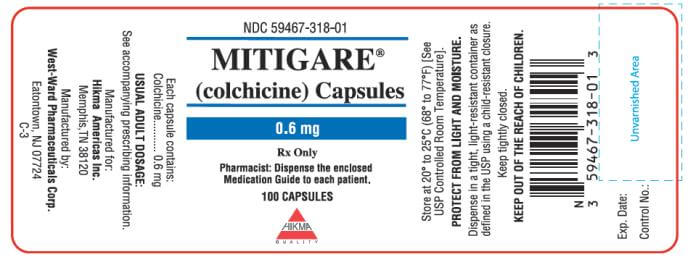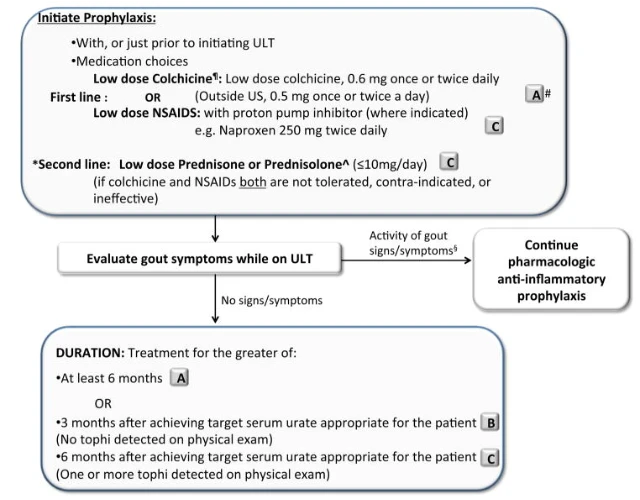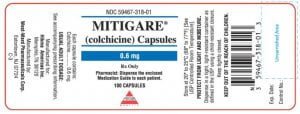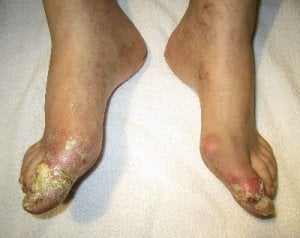How Does Colchicine Help Gout?
Colchicine for gout is not a permanent solution. It isn’t even a temporary solution, but it can be extremely effective at bringing short term gout pain relief.
Why do I say that short term gout pain relief is no kind of solution for gout? Because it should never be used to help gout pain in its own right. It should only be used to allow uric acid lowering treatment programs to be effective.
Colchicine As A Gout Cure
Colchicine For Gout Contents
Historically colchicine has been seen as a gout cure. For centuries, it has been the most effective way to get rid of gout pain.
In less medically advanced times, getting rid of gout pain was a gout cure. That was all that was necessary.
Now we know that the only way to get rid of gout pain is to lower uric acid to safe levels. We know that this is not a permanent cure. However, as long as uric acid is controlled by allopurinol or newer gout medications, then we have gout firmly under control. It is the nearest thing to curing gout that we can currently achieve.
Unfortunately, despite effective uric acid treatment being widely available for over 40 years, there is a persistent recommendation from some quarters to still rely on colchicine as a solution for gout.
Colchicine For Gout Prevention
It has been a common practice to prescribe colchicine as a daily preventative for gout. Medically, this is known as a prophylactic treatment. It prevents (or dramatically restricts) gout pain from taking hold. It works because it stops inflammation spreading. Hence the general advice is to take colchicine at the first sign of a gout attack. Soon is good, so preventative colchicine should be even better – you cannot get any sooner than before the attack starts.
But this opens up the problems of reactions to long-term colchicine use. Coupled with unclear usage guidelines, there have been many issues with colchicine for gout.
Recently, poor colchicine prescribing practices have led to generic colchicine being replaced by Colcrys in the United States. It is exactly the same active ingredient, but dosing guidelines are much clearer. Unfortunately, they still include using colchicine for gout flare prevention (prophylaxis) without making it clear when prevention is justified.
2012 Colcrys dosage research reveal that this is still allowing massive overuse of colchicine, at a significant cost now it is Colcrys.
Correct Use Of Colchicine For Gout
Yes, it is correct to use colchicine for gout flare prevention, but only if the underlying problem of excess uric acid is being managed properly.
Therefore, the correct use of colchicine for gout is to use it during the early stages of uric acid treatment. The early stages mean the weeks or months that it takes to stabilize uric acid at 5mg/dL (0.30mmol/L) or below. This will vary enormously from patient to patient, so it must be managed on an individual basis.
In my case, I was advised to take colchicine as a preventative for 2 weeks when I started allopurinol treatment, and again when the dose was increased. This was very effective for me, and I found that I could manage with one week after the third allopurinol increase. I was also advised to keep colchicine on-hand to take at the first sign of a gout flare. I needed to do this on a small number of occasions, and I never suffered any serious pain.

When to Stop taking Colchicine
When you take colchicine as a preventative, your doctor should advise you when you can stop taking it. But, as far as I know, there are no general guidelines for how long preventative colchicine should last. So, I consider the logic, which tells me you should continue until the risk of a gout flare is acceptable.
Unfortunately, we can never say with absolute certainty that you will never get another gout flare. But if you have gone six months with uric acid under 5mg/dL and without a gout flare, it is extremely unlikely that you will get another flare. So, in that situation, you can stop taking colchicine.
Restarting Preventative Colchicine
Importantly, this is a personal decision for you to balance the risk of a gout flare with the inconvenience of taking colchicine. For example, if you are starting a new job, or going on vacation, you might be more fearful of a gout attack than normal. Firstly, discuss your concern with your doctor, and get their opinion on restarting preventative colchicine.
Assuming your doctor agrees, I recommend restarting colchicine a few days before you need to. Because the last thing you want is stomach problems with that new job or vacation. Also, if you normally support colchicine with other gout pain relief during an attack, you should get a prescription for those. Then, when your critical period has finished, simply stop taking your preventative colchicine and return to normal life.
Storage of Colchicine for Gout
Many gout sufferers ask how to store colchicine and how long it lasts. Because Colcrys is expensive, or because colchicine taken as required might not be needed for a long time, these are important questions.
So, the first thing you should do is to check your colchicine product label. Because that will usually include storage instructions. If not, here are the details from eMC[1]:
Special precautions for colchicine storage
Do not store above 25°C.
Store in the original container.
Also, this is expanded in the Patient Information (Colchicine Product Leaflet)[2] to:
Keep this medicine out of the sight and reach of children.
• Do not take Colchicine Tablets after the expiry date which is stated on the label. The expiry date refers to the last day of that month.
• Do not take Colchicine Tablets if you notice that they are showing signs of deterioration such as discoloration.
• Do not store above 25ºC
• Store in the original package in order to protect from light.
Medicines should not be disposed of via wastewater or household waste. Ask your pharmacist how to dispose of medicines no longer required. These measures will help to protect the environment.
Colchicine shelf life
Three years in polypropylene or polyethylene tablet containers.
Two years in strip packs of opaque white or clear PVC film and 20µ aluminum foil of 10 or 14 tablets.
Colchicine For Your Gout
If you are taking colchicine for gout without a uric acid treatment program, or beyond the first few months, you must see your doctor immediately. Once uric acid has stabilized at 5mg/dL or below, there should be no need for colchicine. If you are still experiencing joint pain, it should be investigated by a rheumatologist.
But, also lower uric acid or you get no gain.
Colchicine For Gout Feedback
GoutPal visitor responses include:
Colchicine Expiration Date
Toofast asked, “The expiration date on my new colchicine bottle is only a year away. Help! This is saving me and I can’t afford to refill with the new prices. What can I do to extend the shelf life? And what can I expect as a new expiration date for my beloved colchicine?”
Colchicine and Colcrys Shelf Life
Andrew shared, “I tried old colchicine after three years and it didn’t work. My pharmacist confirmed the one-year shelf life of Colcrys brand colchicine. But I can’t afford Colcrys. So my doctor prescribes indomethacin for gout attacks. But I know I have to start allopurinol to prevent future attacks.”
Shelf Life of Colchicine GoutPal Response
Your doctor’s prescription is more important than shelf life. Now professional recommendations are not for a fixed term. Because colchicine should be prescribed for at least six months until uric acid treatment becomes effective[3]. So in most cases that will be 6-12 months. But stopping colchicine is always determined by your doctor. Because it relies on blood test results and physical examination.

Therefore, shelf life of colchicine and expiration dates are irrelevant. Because once your doctor stops prescribing colchicine you will never need it again. Due to the fact that your risk of gout flares has been stopped by uric acid treatment.
Now there could be special cases. Such as where colchicine is prescribed for different reasons. Or where uric acid treatment is compromised. But your only option is to discuss your special case with your doctor. Who might also advise you about colchicine beyond its expiry date in your circumstances.
Leave Colchicine For Gout to read other Colchicine pages.
Colchicine For Gout Related Topics
Please remember: to find more related pages that are relevant to you, use the search box near the top of every page.
Common Terms: colcrys, guideline, mitigare, Most Helpful Gout Pages, patient, prevent, result, taking, when to
Other posts that include these terms:
- High Alkaline Foods for Gout Diet Menu
- Gout Foods Table for Vegetables
- Gout Food List for GoutPal Foodies
- Foods High in Uric Acid Chart
- Purine Rich Foods
- Does Alcohol Affect Gout?
- What Foods Cause Gout?
- Is Chinese Food Bad For Gout?
- Is Very Low Purine Gout Diet Possible?
- Edamame and Gout: Vegetable Medley
- Gout Symptoms, Causes, & Diagnosis
- Fish You Can Eat With Gout
- Gout Foods Tables Introduction
- Best Drink For Gout – What’s Yours?
- ACR Gout Management Principles
- Gout and Alcohol: Tequila and Gout
Colchicine For Gout References
- Summary of Colchicine Characteristics (archive September, 2017).
- Colchicine UK Product Label PDF.
- Khanna, Dinesh, Puja P. Khanna, John D. Fitzgerald, Manjit K. Singh, Sangmee Bae, Tuhina Neogi, Michael H. Pillinger et al. “2012 American College of Rheumatology guidelines for management of gout. Part 2: therapy and antiinflammatory prophylaxis of acute gouty arthritis.” Arthritis care & research 64, no. 10 (2012): 1447-1461.
Colchicine For Gout Document Change History
 To read the document change history, click the GoutPal History image on the right.
To read the document change history, click the GoutPal History image on the right.
Do you have suggestions for improving Colchicine For Gout? Then, please share your idea on GoutPal’s Forum. Or, send the Feedback Form, below.
Please give your feedback
Did this page help you? If yes, please consider a small donation. Your donations help keep GoutPal's gout support services free for everyone.
If not, please tell me how I can improve it to help you more.
- YouTube
- The gout forums.
TL;DR - Colchicine For Gout
Key points to remember about colchicine for gout are:
- Colchicine is not a gout cure.
- Colchicine is best as a preventative when you start to lower uric acid.
Need more help? Then get personal gout treatment help from GoutPal.
But, also lower uric acid or you get no gain.








